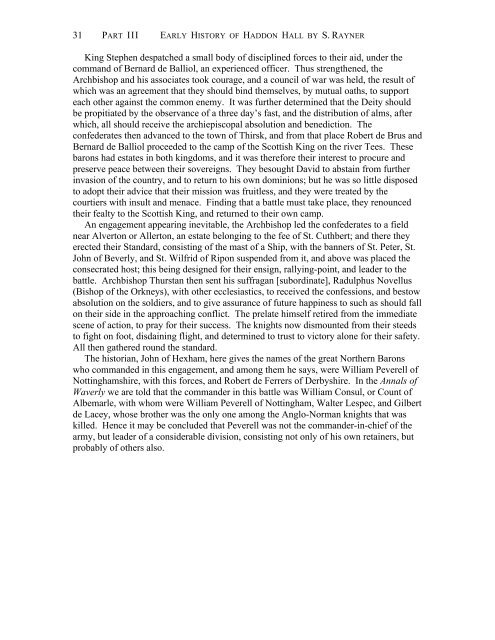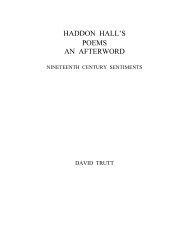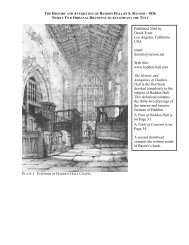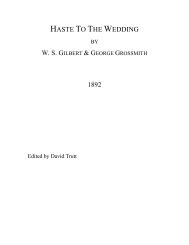Download - Haddon Hall
Download - Haddon Hall
Download - Haddon Hall
You also want an ePaper? Increase the reach of your titles
YUMPU automatically turns print PDFs into web optimized ePapers that Google loves.
31 PART III EARLY HISTORY OF HADDON HALL BY S. RAYNER<br />
King Stephen despatched a small body of disciplined forces to their aid, under the<br />
command of Bernard de Balliol, an experienced officer. Thus strengthened, the<br />
Archbishop and his associates took courage, and a council of war was held, the result of<br />
which was an agreement that they should bind themselves, by mutual oaths, to support<br />
each other against the common enemy. It was further determined that the Deity should<br />
be propitiated by the observance of a three day’s fast, and the distribution of alms, after<br />
which, all should receive the archiepiscopal absolution and benediction. The<br />
confederates then advanced to the town of Thirsk, and from that place Robert de Brus and<br />
Bernard de Balliol proceeded to the camp of the Scottish King on the river Tees. These<br />
barons had estates in both kingdoms, and it was therefore their interest to procure and<br />
preserve peace between their sovereigns. They besought David to abstain from further<br />
invasion of the country, and to return to his own dominions; but he was so little disposed<br />
to adopt their advice that their mission was fruitless, and they were treated by the<br />
courtiers with insult and menace. Finding that a battle must take place, they renounced<br />
their fealty to the Scottish King, and returned to their own camp.<br />
An engagement appearing inevitable, the Archbishop led the confederates to a field<br />
near Alverton or Allerton, an estate belonging to the fee of St. Cuthbert; and there they<br />
erected their Standard, consisting of the mast of a Ship, with the banners of St. Peter, St.<br />
John of Beverly, and St. Wilfrid of Ripon suspended from it, and above was placed the<br />
consecrated host; this being designed for their ensign, rallying-point, and leader to the<br />
battle. Archbishop Thurstan then sent his suffragan [subordinate], Radulphus Novellus<br />
(Bishop of the Orkneys), with other ecclesiastics, to received the confessions, and bestow<br />
absolution on the soldiers, and to give assurance of future happiness to such as should fall<br />
on their side in the approaching conflict. The prelate himself retired from the immediate<br />
scene of action, to pray for their success. The knights now dismounted from their steeds<br />
to fight on foot, disdaining flight, and determined to trust to victory alone for their safety.<br />
All then gathered round the standard.<br />
The historian, John of Hexham, here gives the names of the great Northern Barons<br />
who commanded in this engagement, and among them he says, were William Peverell of<br />
Nottinghamshire, with this forces, and Robert de Ferrers of Derbyshire. In the Annals of<br />
Waverly we are told that the commander in this battle was William Consul, or Count of<br />
Albemarle, with whom were William Peverell of Nottingham, Walter Lespec, and Gilbert<br />
de Lacey, whose brother was the only one among the Anglo-Norman knights that was<br />
killed. Hence it may be concluded that Peverell was not the commander-in-chief of the<br />
army, but leader of a considerable division, consisting not only of his own retainers, but<br />
probably of others also.







